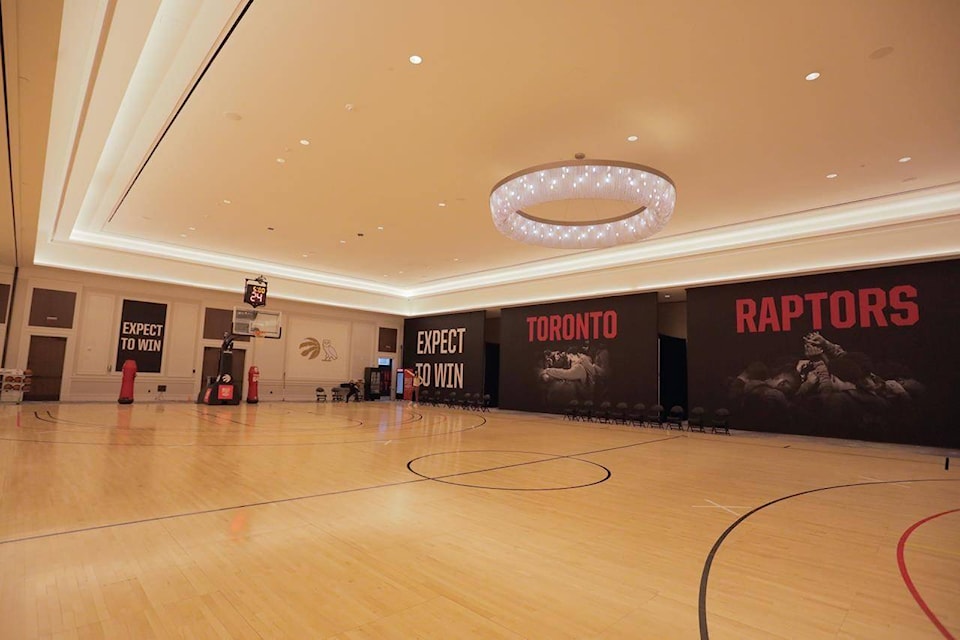There’s a large framed photo of Nick Nurse performing on stage with the Arkells hanging in his new glass-walled office at Tampa’s JW Marriott.
It’s one of the many touches of home the displaced Raptors packed up and moved once they chose the city on Florida’s west coast as their temporary digs for this unusual NBA season.
The Raptors announced Nov. 20 they would begin the season in Tampa after running out of time on talks with government officials at home. Barely three weeks later, they opened their new practice facility built in the Marriott, the largest ballroom space available in Tampa.
“Oh, it’s awesome, it’s awesome,” Nurse said. “It’s a really impressive setup. It’s eye-catching. Right when you come in it’s like ‘Whoa.’”
The Raptors hired BaAM Productions, a Toronto-based event experience company, to create the build-out. The Toronto Blue Jays had worked with BaAM on their temporary home last summer in Buffalo.
Built over two ballrooms, the space includes two courts from the Walt Disney World bubble, coaches offices, a video room, weight room — half of the weights were flown in from Toronto, the other half were purchased in Tampa — a training room and locker rooms.
New Raptor Alex Len said the facility has “way more space” than his former team the Suns had in Phoenix.
“It looks amazing. They did an amazing job. They had like two weeks to put this whole thing together,” Len said.
Thanks to the Disney bubble, the Raptors knew the ballroom concept would work, and the Marriott, because it’s brand new, was ideal. The Raptors were the hotel’s first guests.
Still, it presented unique challenges. There are only four baskets in total because side hoops were too tricky to install in this type of event space. Side lights and some low-hanging chandeliers were removed.
“There’s bets on how soon one of those things hanging from the ceiling will get hit,” said Teresa Resch, the Raptors’ vice-president of basketball operations.
Team president Masai Ujiri inserted a lucky toonie into the floor last week. There are other nods to the team’s OVO Centre in Toronto such as the artwork in Nurse’s office. But the Raptors didn’t aim for a carbon copy of their facility back home.
“There’s probably going to be a portion of the staff that will want stay here forever because they have it better, and there’s a portion of the staff that are going to say I want to go back home really soon,” Resch said. “And then the players, I think, as long as there’s a ball and a basket, they’re usually OK.”
The Raptors remained hopeful they’d be able to play out of Scotiabank Arena this season, and Resch said they were in the very preliminary planning stages of looking elsewhere when the team and levels of government “mutually agreed the time was running out.”
“We were having good discussions but we weren’t quite there, and we just had to make the decision and operationally we had targeted knowing that we needed about two weeks to really hit go and get everything done that we needed to,” she said.
The available ballroom space, and getting an agreement to play games at Amalie Arena, normally home to the NHL’s Lightning, were two big check marks for Tampa.
Because of Canada’s travel restrictions around COVID-19, and rising cases in Ontario, the Raptors are the NBA’s only team forced to play outside its market this season. Raptors GM Bobby Webster said recently there was a chance the league would chip in financially. There is a contingency fund that was used after the Boston Marathon bombing and when the New Orleans Hornets had to move to Oklahoma City.
“The one thing I can say is that the NBA has been with us every step of the way sharing resources, learnings and making sure that we are going to be at as equal a playing field as any other team in the league is as possible,” Resch said.
The biggest impact, she said, hasn’t been the relocation to Tampa, but the global pandemic itself.
“Everything’s changed from how we used to operate and that’s the biggest thing honestly, is the space, the social distance, all the protocols, we get five memos from the league every single day, so I would say that that’s playing a much huger role than being in a different city or different practice area,” Resch said.
The NBA was the first major North American league to shutter last March due to the global pandemic, and their resumption in the bubble at Disney World, with no positive COVID-19 tests, was a huge success.
The Raptors, who were ousted from the bubble by Boston in the second round of the playoffs, announced earlier this week that they’d permit a limited number of fans at their games at Amalie Arena, including Friday’s pre-season finale against Miami. They host the the New Orleans Pelicans on Wednesday to tip off the regular season.
Much of their success this season, Nurse has said, will come from being flexible. Ujiri has said the Raptors’ strength is their ability to come together to overcome challenges. Fans or no fans, Toronto or Tampa, the team is happy to be back playing.
And last summer’s bubble showed what’s possible.
“That’s the thing that’s made this transition a bit easier is everybody’s existed in a ballroom setting with basketball, and not only existed but it was great,” Resch said. “I think if we would have done this without having had that experience, not just us but the whole league, I think there would have been a lot of ‘I don’t know if that can happen.’
“But that (the players) already did that once, and it was great, really, they were open to it and accepting and understand that it can be done, it can be done really well.”
This report by The Canadian Press was first published Dec. 17, 2020.
Lori Ewing, The Canadian Press
